What Is ntoskrnl.exe BSOD
Just as the name says, the ntoskrnl.exe BSOD error is related to ntoskrnl.exe. When it occurs, you can see “What failed: ntoskrnl.exe” on the blue screen. So, what is ntoskrnl.exe?
Ntoskrnl.exe, short for Windows NT Operating System Kernel Executable, is a core system file in Windows. It manages hardware abstraction, process handling, and memory management. This legitimate Microsoft file is safe and not malware.
It contains the kernel and executive layers, bridging hardware and software to manage processes, memory, and essential system functions. Windows cannot operate without a functioning ntoskrnl.exe file.
Before the ntoskrnl.exe error occurs, your PC may exhibit these symptoms:
- Slow performance on your PC
- Random system restarts
- High CPU usage
- Overheating issues
So, what causes the ntoskrnl.exe blue screen error? The following sections explain the main reasons.
Why Does ntoskrnl.exe BSOD Occur
Understanding the causes of ntoskrnl.exe BSOD error is essential before choosing the appropriate method to resolve it.
After investigating extensive user reports and posts, I find that the error can mainly be caused by the following reasons:
- Corrupted or incompatible device drivers
- Outdated Windows
- Faulty Windows updates
- Outdated graphics card or monitor driver
- Corrupted system files
- Faulty RAM
- Disk errors or bad sectors
- Virus or malware infection
- Overclocking settings
Do a Preparation Before Fixing ntoskrnl.exe BSOD
Before you start fixing the ntoskrnl.exe failed error, you need to take some measures to keep your data safe. Here’s what you can do:
Option 1. Clone Data to Safe Location
If your computer can boot into the normal Windows interface, you just need to copy all your data to another safe location to protect your files.
To do that, I highly recommend MiniTool Partition Wizard. It offers the Copy Disk feature to help you clone all the data from one disk to another with ease.
Here’s how to do that:
Step 1. Download and install MiniTool Partition Wizard Pro or a higher edition on your computer. Then, launch this software to enter its main interface.
MiniTool Partition Wizard DemoClick to Download100%Clean & Safe
Step 2. Choose the system disk from the disk map, and select Copy Disk from the left panel.
Step 3. In the pop-up Copy Disk Wizard window, choose the target disk (preferably a blank disk), and click Next to move on.
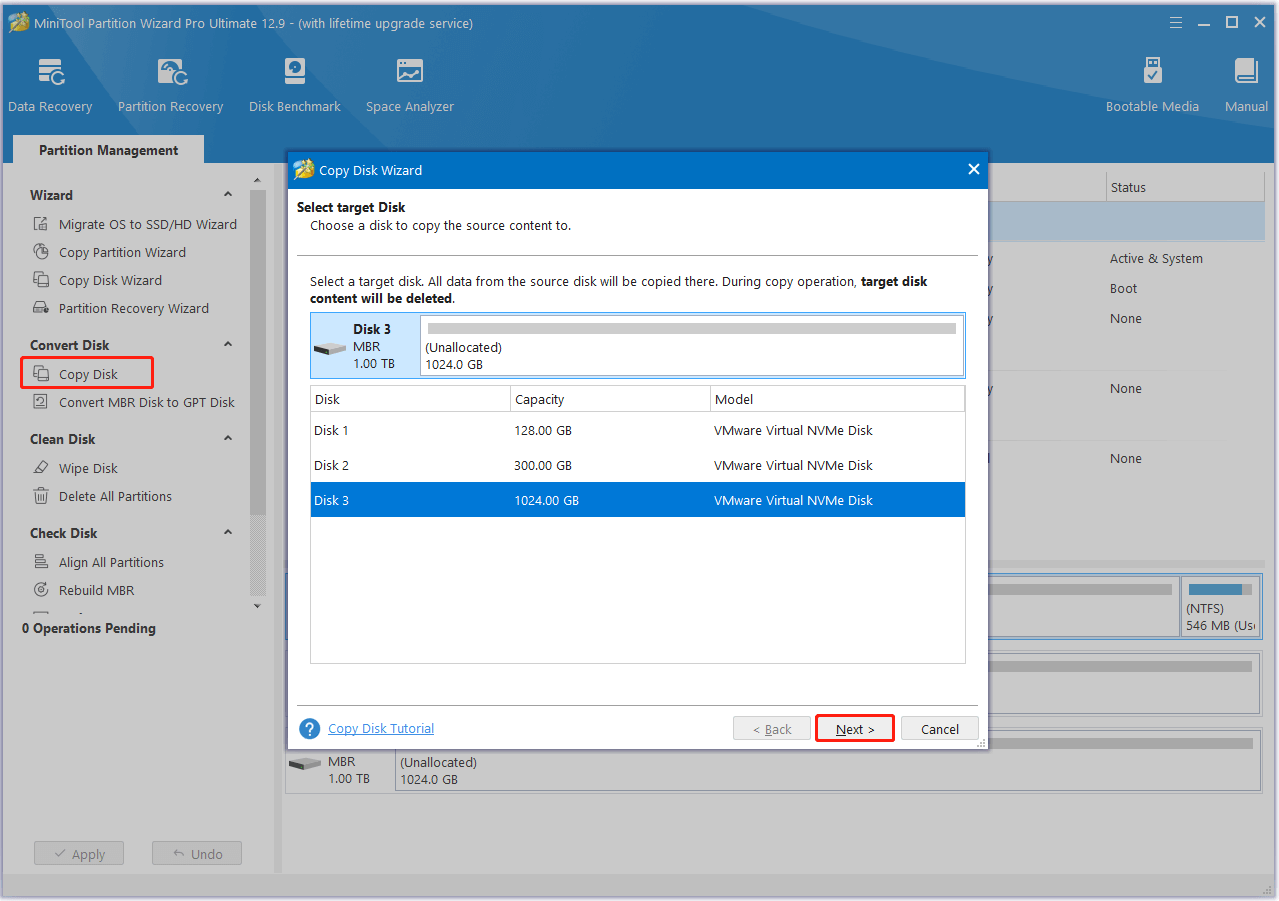
Step 4. In the next window, you need to set Copy Options and adjust Target Disk Layout. Here’s what these options mean:
- Fit partitions to entire disk. When you choose this option, the partitions on your original disk will take up the space on the target disk at the original rate of size.
- Copy partition without resizing. If you choose this option, you can clone all partitions from the original disk to the target disk while keeping all partitions the same size. The extra capacity, now larger, will be unallocated and ready for use.
- Align partition to 1MB. Normally, this option is already checked by default. It can improve performance for Advanced Format disk & SSD.
- Use GUID Partition Table for the target disk. If your target disk is larger than 2TB and you want to turn it into a GPT disk, you can check this option.
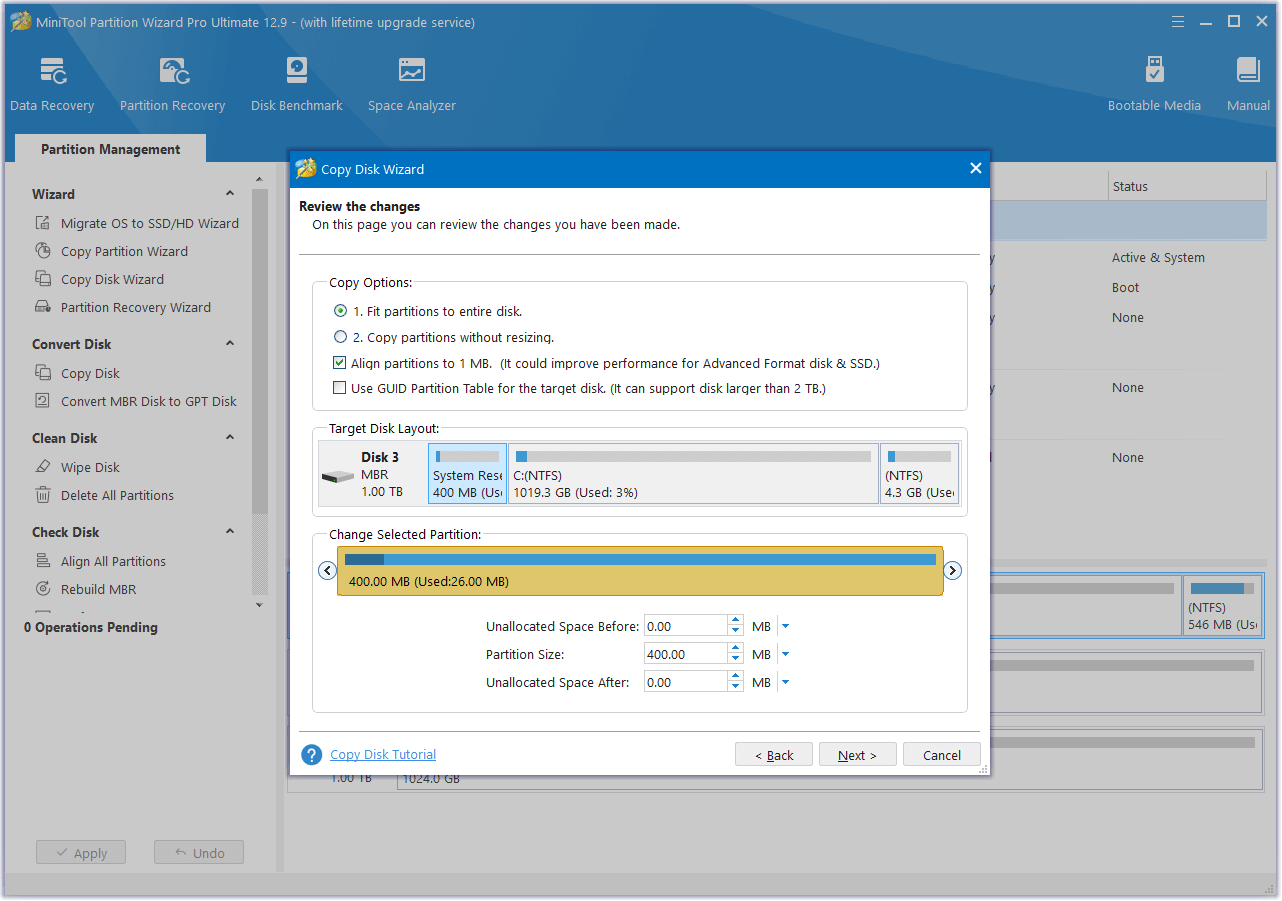
Step 5. Read the Please Note carefully and click Finish to return to the main interface.
Step 6. Click Apply at the bottom left corner. Then, click Yes in the pop-up window to confirm the operation.
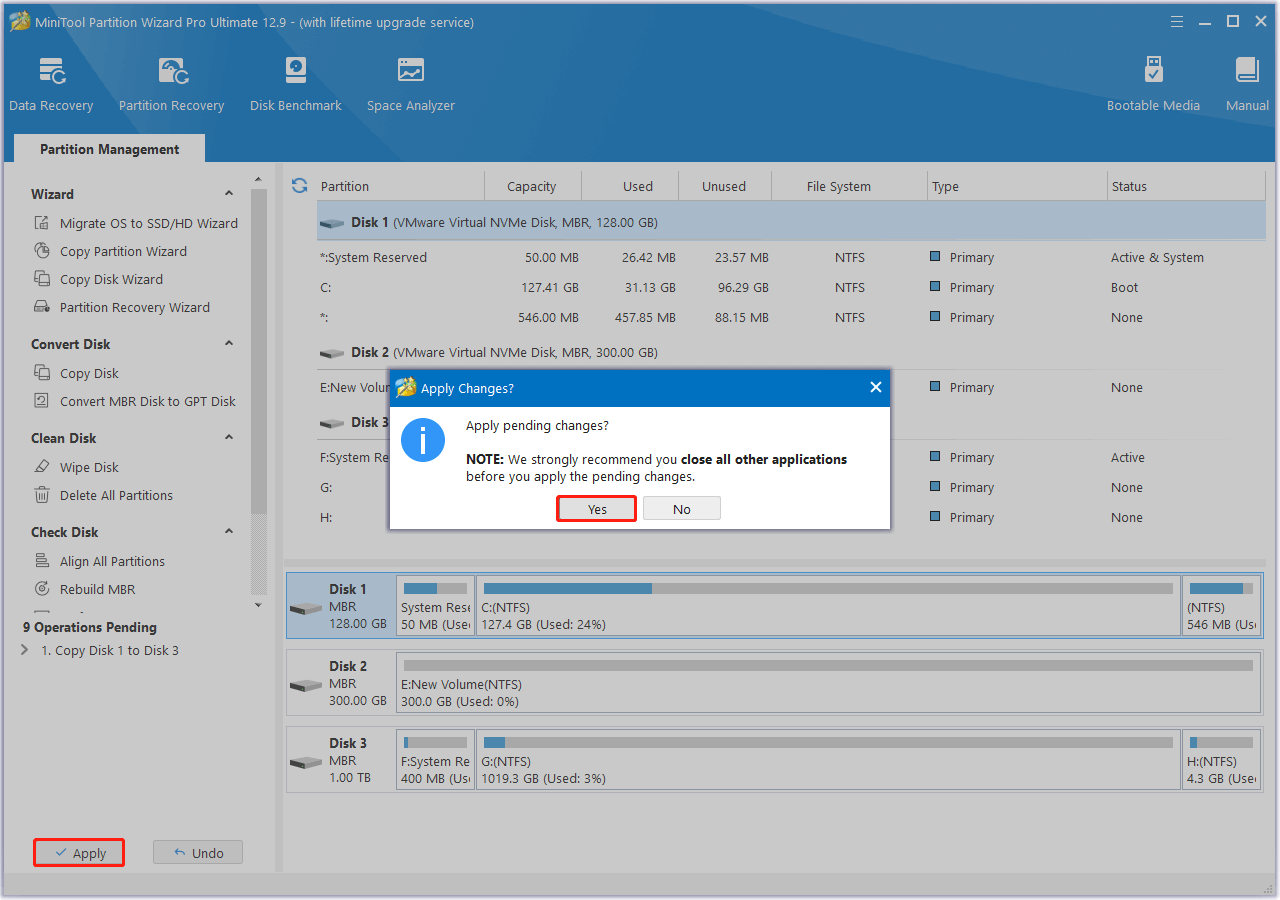
After completing these steps, your system disk has been cloned to the target disk.
Option 2. Recover Data to a Safe Location
If your computer can’t boot into the normal Windows interface, you need to recover all your data in WinRE to keep your data safe first.
To do that, you need to create a MiniTool bootable USB media and then boot from it to perform the data recovery. Here’s the guide:
# 1. Create MiniTool bootable USB media
Step 1. Connect your USB flash disk to a working computer. Then, download and install MiniTool Partition Wizard on this PC.
MiniTool Partition Wizard DemoClick to Download100%Clean & Safe
Step 2. Launch this software and click Bootable Media in the top right corner.
Step 3. Click WinPE-based media with MiniTool plug-in.
Step 4. Choose USB Flash Drive. If you get a window with notice “The data on the USB disk will be destroyed. Are you sure you want to build a USB boot disk?”, click Yes to move on.
Step 5. After the bootable USB media is created, click Finish.
# 2. Perform data recovery
Step 1. Boot your PC from the created MiniTool bootable USB flash drive.
Step 2. Click Data Recovery from the top toolbar.
Step 3. Go to the Devices tab, choose the system disk, and click Scan.
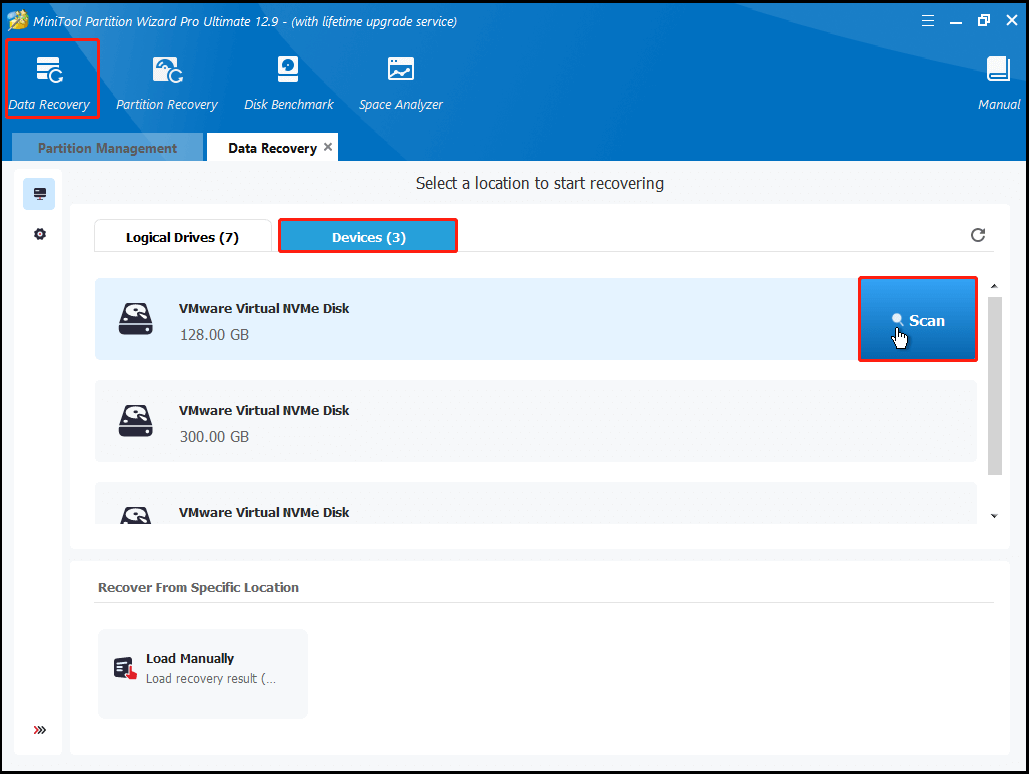
Step 4. Once the scanning process is complete, check all the needed files and click Save.
Step 5. Then, choose a new location except their original location and click OK to store the recovered files.
How to Fix ntoskrnl.exe BSOD
To fix the ntoskrnl.exe failed error, you can try updating Windows and drivers, uninstalling recent problematic updates, scanning for malware, checking RAM, resetting overclocking settings, running SFC and DISM, fixing disk errors, performing a system restore, etc.
If your computer can boot into Windows normally, you can try the following methods directly to fix the error. If not, you need to boot into safe mode with networking first.
Here’s the detailed breakthrough:
Boot into Safe Mode
To boot into safe mode, please do the following steps:
Step 1. Force your computer to shut down and restart it three times to trigger the automatic repair environment. Then, click Advanced options.
Step 2. In the Choose an option screen, select Troubleshoot > Advanced options > Startup Settings.

Step 3. Click the Restart button.
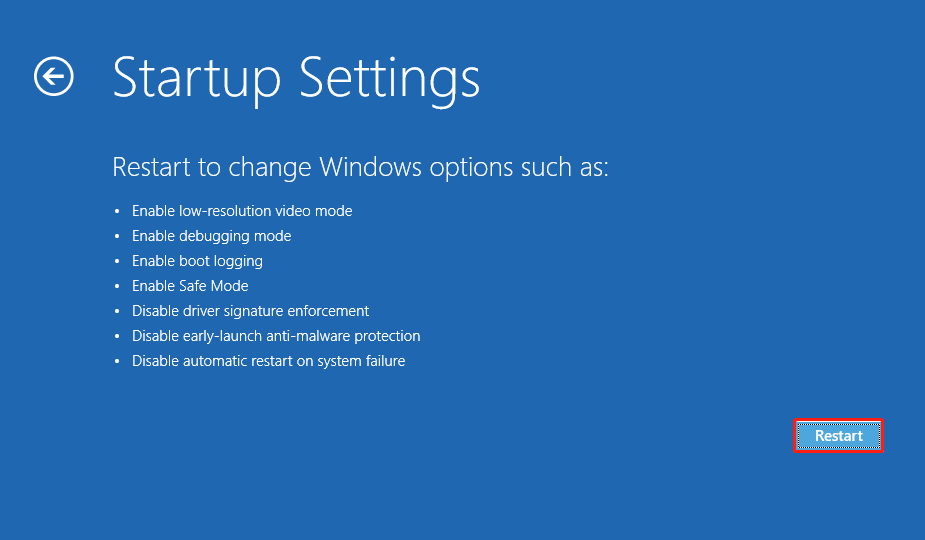
Step 4. Press number 5 or F5 to enable Safe Mode with networking.
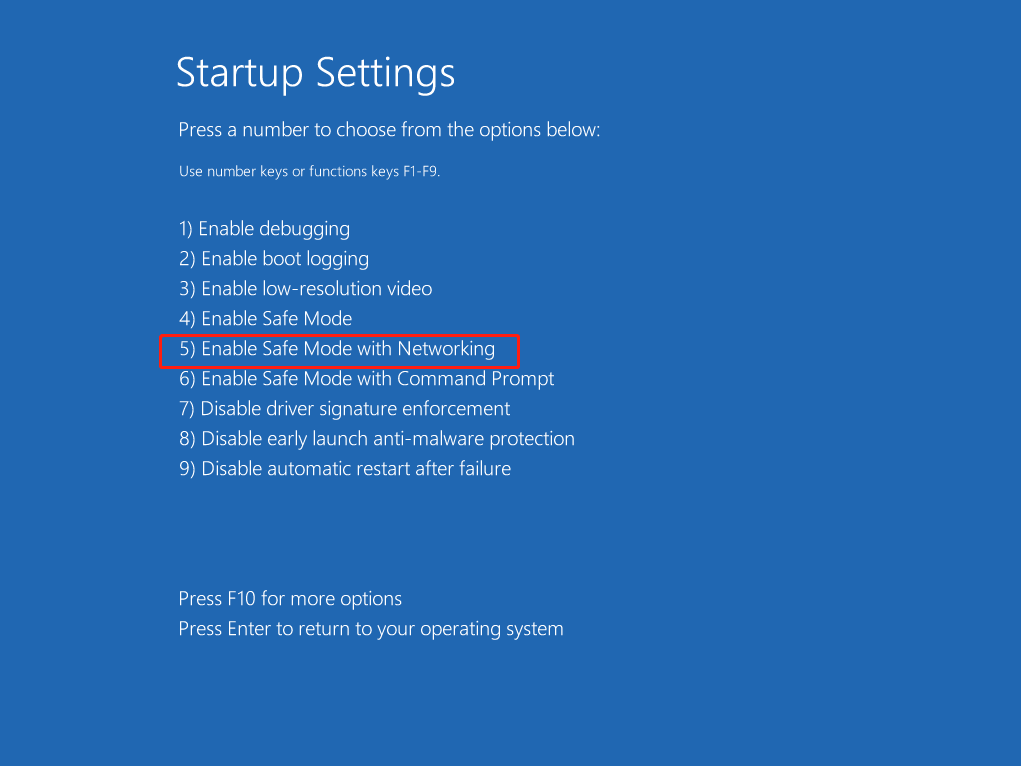
Method 1. Update Your Device Drivers
An outdated video card or monitor driver may cause the BSOD ntoskrnl.exe error. In this case, you can try updating the outdated graphics card driver or monitor drivers to fix the error. Here’s how to do that:
Step 1. Press the Win + X to open the Quick Link menu, and select Device Manager from the menu.
Step 2. In the Device Manager window, expand the Display adapters category. Then, right-click the outdated graphics card driver and select Update driver.
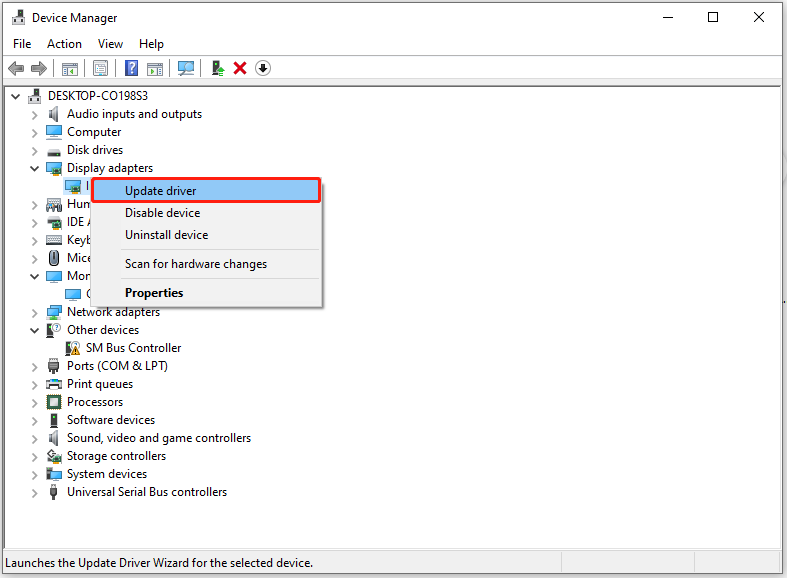
Step 3. Choose Search automatically for drivers and then follow the on-screen guide to complete the process.
Step 4. Expand the Monitor category and repeat the same steps to update the outdated monitor driver.
Step 5. Once done, restart your computer and check if the error has been resolved.
Method 2. Install Windows Updates
An outdated Windows can also be related to the BSOD ntoskrnl.exe error. In this case, you can try updating it to the latest version to fix the error. Here’s the guide:
For Windows 10:
- Press the Win + I keys to open Settings.
- Navigate to Update & Security > Windows Update.
- Click Check for updates.
- If there are available updates, update them.
For Windows 11:
- Open the Settings window.
- Select Windows Update from the left panel.
- Click Check for updates to check and update Windows.
Method 3. Uninstall Problematic Windows Update
If you encounter the BSOD ntoskrnl.exe in Windows 11/10 after installing the latest Windows update, you can suspect that the newly installed update causes the error.
To fix the error, you can try uninstalling the latest Windows update. Here are the steps:
- Open the Windows Update window.
- Choose View update history.
- Click Uninstall updates.
- Select the latest update from the list.
- Then, click Uninstall and follow the on-screen instructions to complete it.

Method 4. Scan for Malware
A virus infection or malware can lead to the ntoskrnl.exe BSOD in Windows 10 easily. If you suspect the error on your PC is caused by this reason, you can try running a full virus scan to fix the error.
Here’s how to use Windows Security to scan viruses and malware:
Step 1. Press Win + S to open the Search window, type “virus & threat protection” in the box, and press Enter.
Step 2. Click Scan options in the pop-up window.
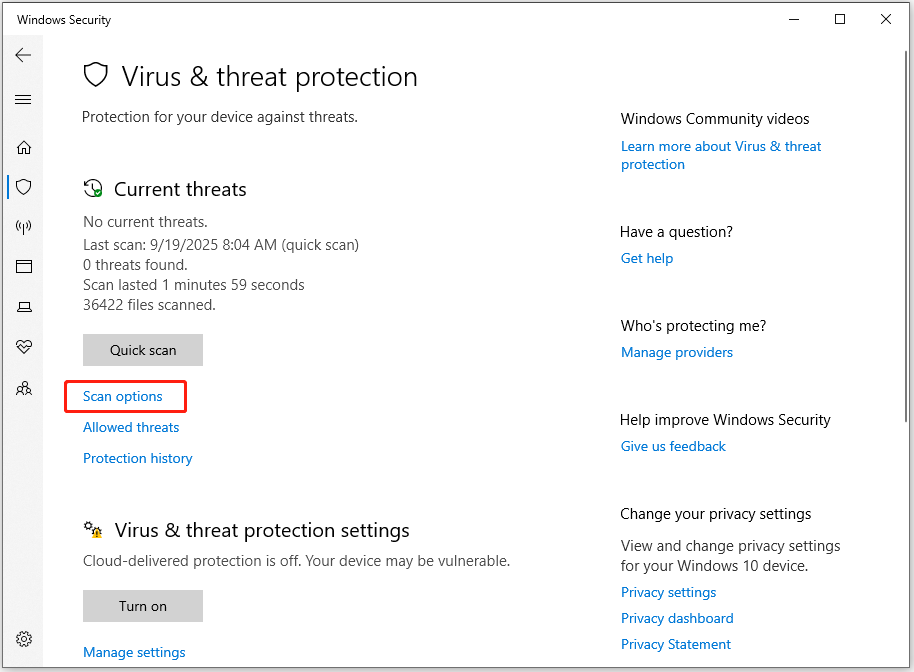
Step 3. Choose Full scan and click Scan now. Then, this tool will start to scan for viruses or malware on your PC.
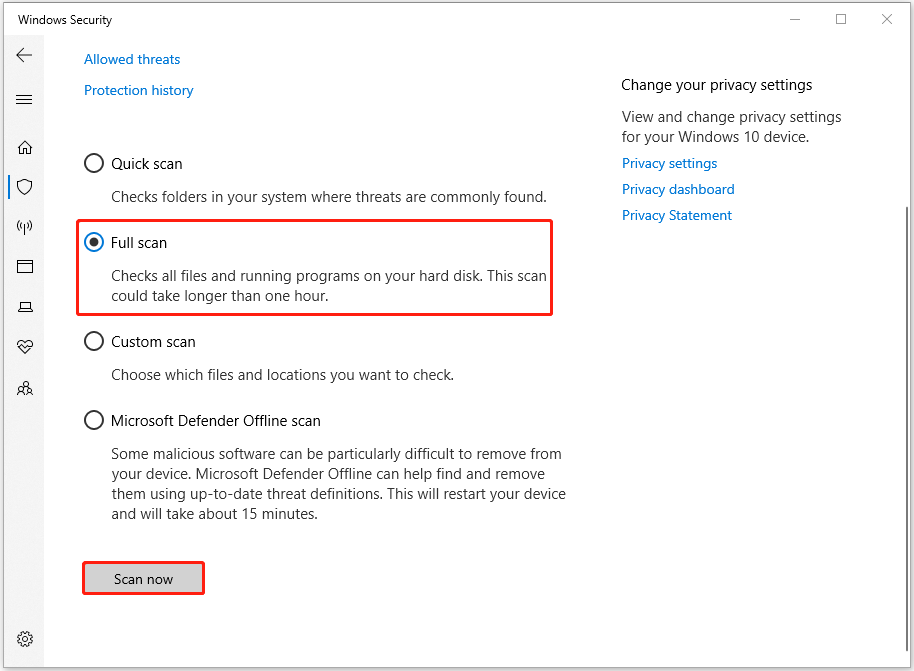
Step 4. Once the scanning process is done, remove the found viruses or malware.
Step 5. Now, restart your computer and check if the error has been resolved.
Method 5. Perform a Clean Boot
The ntoskrnl.exe BSOD in Windows 10/11 can be caused by a corrupted driver or a conflicting program. If you are unable to identify the culprit, you can perform a clean boot to start Windows with only essential drivers and startup programs, and then find it with ease.
Here’s how to perform a clean boot:
Step 1. Press Win + R to open the Run window, and then type “msconfig” in the box.
Step 2. Click on the OK button to open the System Configuration window.
Step 3. Go to the Services tab and check the Hide all Microsoft services option. Then, click on the Disable all button, and the Apply button.
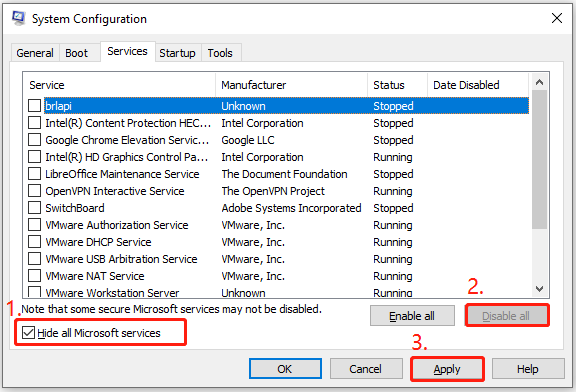
Step 4. Go to the Startup tab and click on Open Task Manager.
Step 5. Right-click the one enabled startup item and select the Disable option from the menu. Then, repeat for all enabled startup items.
Step 6. Exit Task Manager. Next, click OK in the System Configuration window, and then restart your computer.
Step 7. Now, you are in a clean boot environment. Next, see if the problem occurs. If not, it means a non-Microsoft service or startup item was the cause.
Step 8. Re-enable services and startup items in small groups (half at a time), restarting after each change. Repeat until the issue reappears to identify the culprit.
Method 6. Check Your Computer’s Memory
RAM issues can also trigger the BSOD ntoskrnl.exe in Windows 11/10. Therefore, you can try performing a memory test via Windows Memory Diagnostic to solve the ntoskrnl.exe blue screen error.
Step 1. Open the Search window, type “windows memory diagnostic” in the search box, and press Enter.
Step 2. Ensure your work is saved, click Restart now and check for problems (recommended). Then, your computer will restart immediately and start the checking process.
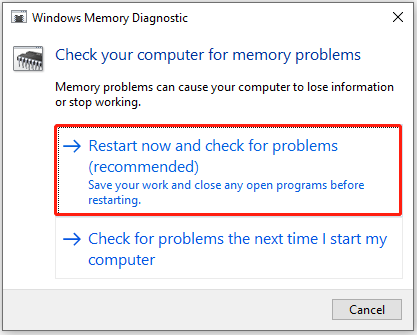
Step 3. When it’s finished, your PC will reboot. Then, open the Run window, type “eventvwr.msc” and press Enter to open Event Viewer.
Step 4. Select Windows Logs > System. Then, find the latest MemoryDiagnostics-Results from the list to check if there is anything wrong with the RAM. If the Event ID is 1201 or 1101, it indicates that the RAM is functioning correctly.
Method 7. Reset Overclocking Settings
Overclocking on your computer may also be responsible for the ntoskrnl.exe blue screen error. If you have done some overclocking settings and encounter the error, you can try resetting these settings to the default in BIOS to fix it.
Here’s how to do that:
- Boot your computer to enter the BIOS menu.
- Press F9 to load setup defaults.
- Press Enter to proceed.
- After that, press F10 to save the changes and exit the BIOS menu.
Method 8. Update BIOS/UEFI
An outdated BIOS/UEFI is one of the most common reasons that may cause the ntoskrnl.exe failed error in Windows 10/11. In this case, you can try updating your BIOS/UEFI to fix the error. Here’s how to do that:
Step 1. Navigate to your manufacturer’s official website.
Step 2. Download the latest BIOS/UEFI for your specific model.
Step 3. Connect a USB flash drive to your PC, and format it to the FAT32 file system.
Step 4. Copy the downloaded BIOS file to the root directory of the USB drive.
Step 5. Restart your computer and boot into the BIOS menu.
Step 6. Find the BIOS/UEFI update utility (may be named as EZ Flash, Q-Flash, M-Flash, or similar) and select it.
Step 7. Choose the BIOS file from the USB drive, confirm the update, and follow the on-screen instructions to complete the process.
Once done, your computer will restart automatically. Now, check whether the error is fixed.
Method 9. Run System File Checker (SFC) and DISM
Corrupted system files may also trigger the ntoskrnl.exe blue screen error. In this situation, you can do the following things to fix the error:
Run SFC command:
Step 1. Open the Search window and type “cmd” in the search box.
Step 2. Right-click Command Prompt and select Run as administrator.
Step 3. In the elevated Command Prompt window, type “sfc /scannow” and press Enter.

Step 4. Now, the SFC command can scan for corrupted or missing system files and repair or replace them. Then, restart your computer to apply the changes.
Run DISM command:
Step 1. Do the same steps as above to run Command Prompt as administrator.
Step 2. In the elevated Command Prompt window, type “DISM.exe /Online /Cleanup-image /Scanhealth” and press Enter.
Step 3. Execute the command “DISM.exe /Online /Cleanup-image /Checkhealth”.
Step 4. Run the “DISM.exe /Online /Cleanup-image /Restorehealth” command.
Step 5. Once done, restart the computer to check if the error has been resolved.
Method 10. Check Disk Errors
Errors or bad sectors on the disk can lead to the ntoskrnl.exe Blue Screen of Death (BSOD) error. To resolve this issue, it’s important to fix any disk errors and identify bad sectors.
I highly recommend using MiniTool Partition Wizard, which includes a “Check File System” feature to diagnose and repair errors, as well as a “Surface Test” feature to scan for and display bad sectors.
Here’s how to use the Check File System and Surface Test features:
Step 1. Launch MiniTool Partition Wizard to enter the main interface.
MiniTool Partition Wizard FreeClick to Download100%Clean & Safe
Step 2. Run the Check File System feature.
- Choose the system partition from the disk map.
- Then, select Check File System from the left panel.
- Choose Check & fix detected errors and click Start.
- Click Yes to confirm.
- After that, restart your PC, and then the scanning will start.
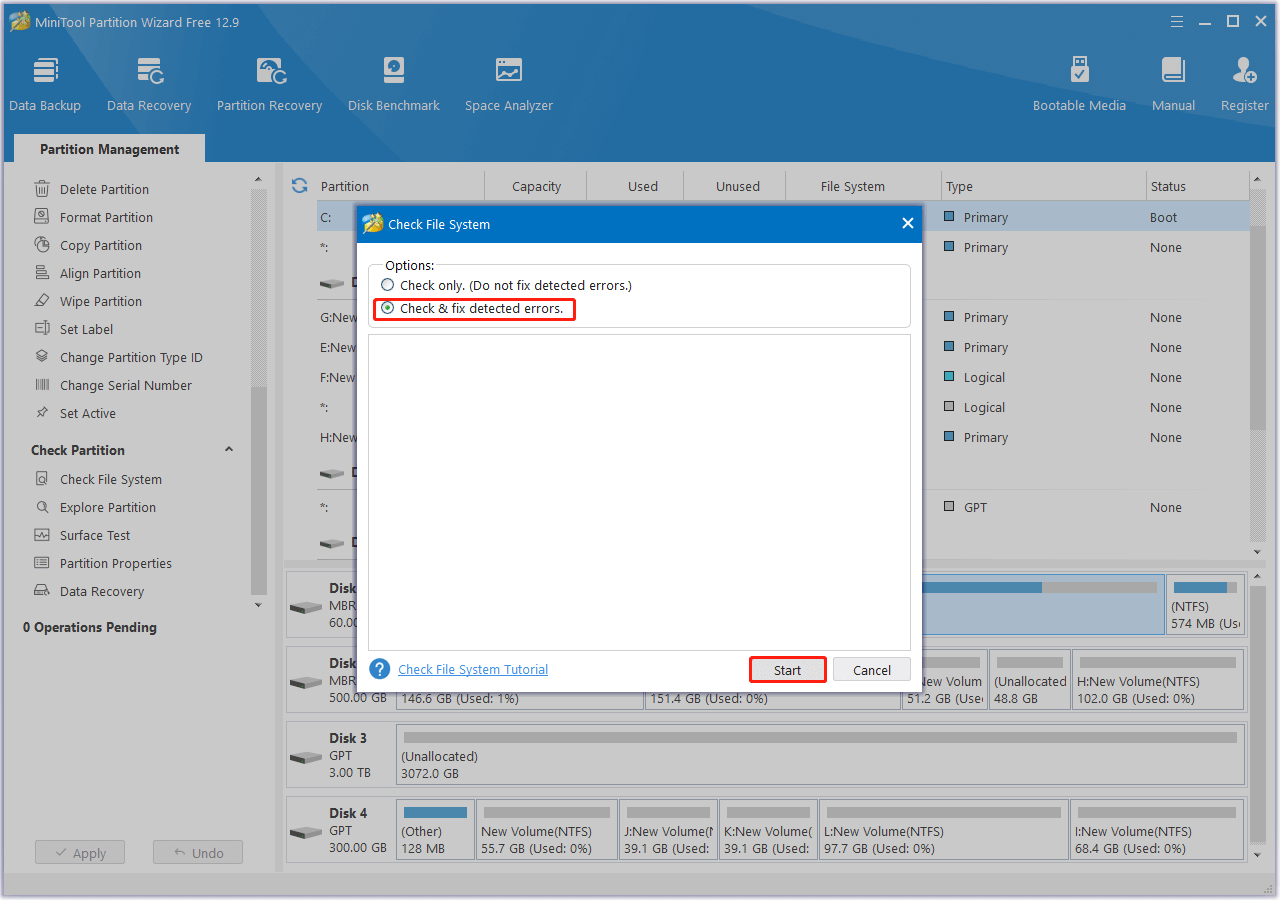
Step 3. Perform the Surface Test feature.
- Choose the system partition or disk.
- Then, select Surface Test from the left panel.
- Click the Start now button.
- Once done, normal sectors will show in green while bad sectors are in red.
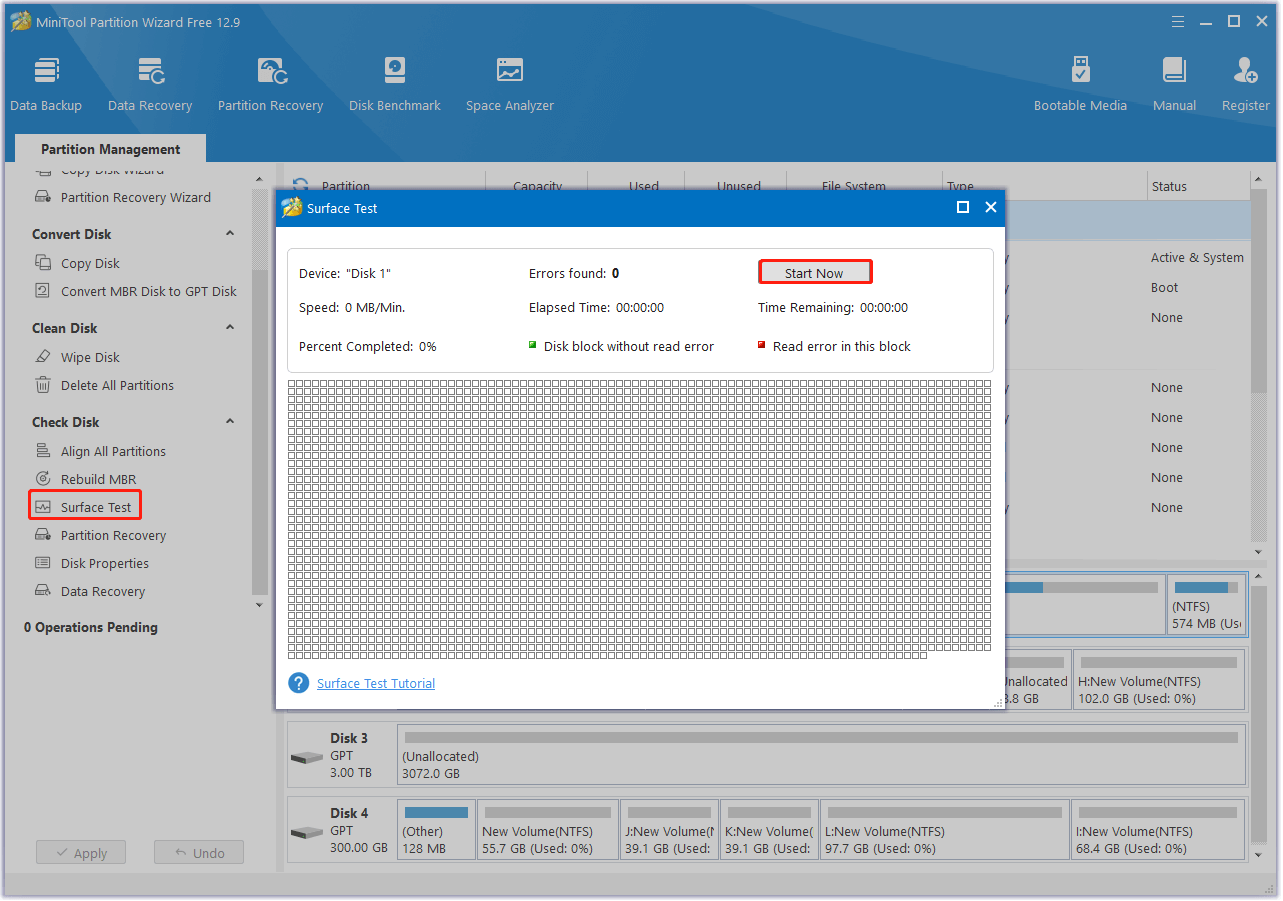
If the Surface Test scanning finds some bad sectors on your disk, you can perform the CHKDSK command with parameters/x and /r to solve the problem.
- /r: Locates bad sectors and recovers readable data. The disk must be locked, and it includes all functions of /f along with physical error analysis.
- /x: Forces the volume to dismount if needed, invalidating all open handles, and includes all functions of /f.
To perform the CHKDSK command with parameters /r and /x, please do the following steps:
- Run Command Prompt as administrator.
- Type “chkdsk /r /x” in the elevated Command Prompt window and press Enter.
- Press Y to check the partition next time the Windows system restarts.
- Restart your PC, and the CHKDSK check will start.
- Once done, all bad sectors will be marked. Then, the Windows system will not write data on the bad sectors.

Method 11. Perform a System Restore
Performing a system restore can return your operating system to a previous state free of errors. If you have created restore points for your Windows operating system, you can attempt to use System Restore to resolve the ntoskrnl.exe Blue Screen of Death (BSOD) error.
To perform a system restore, you can do the following steps:
Step 1. Open the Settings window and choose System.
Step 2. Select About, and then click the System protection link under the Related setting section in the right panel.
Step 3. Under the System Protection tab, click the System Restore button.
Step 4. Click Next in the pop-up window.
Step 5. Select a restore point that was created before the error occurred, and click Next to continue.
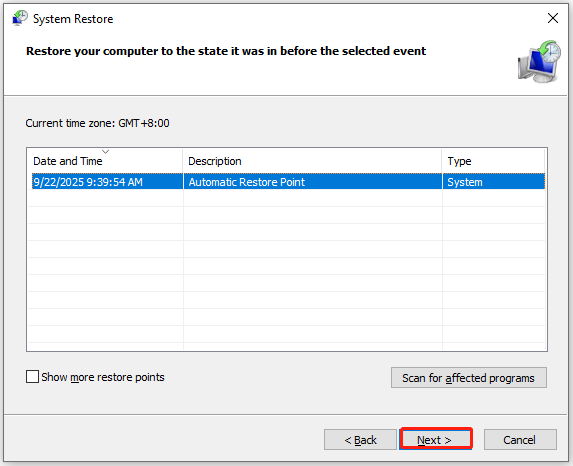
Step 6. Click Finish to confirm the chosen restore point.
Step 7. A window with the sentence “Once started, System Restore cannot be interrupted. Do you want to continue?” will pop up, click Yes to move on.
Step 8. Wait for this process to be completed. Once done, your Windows will revert to the previous state as you select. Then, check if the error has been resolved.
In Conclusion
After reading this post, you may already know what causes the ntoskrnl.exe BSOD error and how to troubleshoot the error successfully with several easy methods. Also, this post introduces MiniTool Partition Wizard to help you copy or recover your data to a safe location.
What’s more, if you encounter any issues or have any suggestions while using MiniTool Partition Wizard, you can contact us by sending an email to [email protected]. We will reply to you as soon as possible.
Ntoskrnl.exe BSOD FAQ
If the problem persists, use Windows Startup Repair, run a System File Checker (SFC) scan, check for hardware issues with chkdsk, or consider System Restore or a PC reset as last resorts.
For a specific program, use the Control Panel repair option or reinstall it.
For general EXE issues, run the System File Checker (SFC) tool with the command sfc /scannow in an administrator Command Prompt, or fix broken file associations in Windows Settings or the Registry Editor.

User Comments :